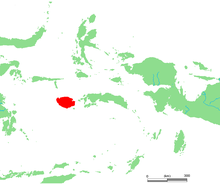Burute dove
| Burute dove | ||||||||||
|---|---|---|---|---|---|---|---|---|---|---|

Buro pigeons |
||||||||||
| Systematics | ||||||||||
|
||||||||||
| Scientific name | ||||||||||
| Treron aromaticus | ||||||||||
| ( Gmelin , 1789) |
The Burute Dove ( Treron aromaticus ), also known as the Moluccan Pompadur Dove , is a short-tailed species of pigeon birds. It is endemic to a single Indonesian island. It has long been considered a subspecies of the Sri Lankan Pompadour Pigeon , but the differences to this species are so pronounced that it is consistently recognized as an independent species.
The stock situation of Burutaube is on the IUCN endangered with potentially ( near threatened ) specified because the population numbers steadily decline.
Appearance
The burute dove reaches a body length of 28 centimeters. It is a medium-sized, compactly built pigeon with a powerful beak that is about the size of a laughing pigeon . The gender dimorphism is only slightly pronounced. The main difference between the two sexes is the color of the coat. The female lacks the chestnut brown color here.
The front of the head is whitish gray, the crown and the neck are gray, the reins and the narrow stripe above the eyes are olive. The rear neck is dark olive, the coat is maroon in the male. In some individuals, the coat is set off from the neck by a gray band.
The small wing covers are dark slate gray. The top row of feathers in the middle wing-coverts is dark olive-colored with bright yellow edges. The remaining feathers of the middle wing-coverts are black with narrow yellow edges. The large elytra are black with sulfur-yellow edges on the outer flags. The arm wings are black and also have yellow edges. The wings are black with narrow yellow or white borders. The back is dark olive, the upper tail covers are a little lighter. The middle control springs are bright olive, the other control springs are olive to gray on the top. A wide pale gray end band runs over the outer control springs.
The chin and throat are greenish yellow. The breast is also light olive. The belly is light to whitish gray-green. The thighs are dark gray-green and usually have broad yellow hems. The under tail-coverts are green-whitish. The control springs are black on the underside with a wide pale gray end band. The iris is pink with a pale blue outer ring. The narrow orbital ring is blue. The wax skin and the base of the beak are dark, the tip of the beak is bluish horn-colored. The feet are brick red.
Distribution area
The Burute dove is limited in its distribution to the Indonesian island Buru , which belongs to the island group of the Moluccas . The heavily forested island is 8,473 km² and is inhabited by around 125,000 people. Buru has a number of island endings. At least ten species of birds are unique to this island. These include the Mada spatula- tailed parrot , the Burupieper and the very rare Burulori, which is threatened with extinction .
The Burutaube inhabits forests, forest edges and tall secondary forests on this island up to an altitude of 730 meters. It is considered potentially threatened because it is hunted on the island and at the same time threatened by deforestation.
Way of life
The burute dove occurs predominantly in small troops of up to a dozen individuals. Larger groups can also gather on very rich fruit-bearing trees.
The food spectrum includes a very wide range of fruits, berries and buds. Figs, which the pigeons usually peck directly from the branch, play a special role in the diet. This pigeon comes to the ground mainly to drink. As is typical for pigeons, the nest is a loose platform made of small branches. The clutch consists of two eggs. Both parent birds are involved in the incubation of the eggs. The nestlings hatch 12 to 14 days after the start of breeding.
literature
- David Gibbs, Eustace Barnes, John Cox: Pigeons and Doves - A Guide to the Pigeons and Doves of the World. Pica Press, Sussex 2001, ISBN 90-74345-26-3 .
- Gerhard Rösler: The wild pigeons of the earth - free living, keeping and breeding. M. & H. Schaper Verlag, Alfeld-Hannover 1996, ISBN 3-7944-0184-0 .
Web links
- Treron aromaticus in the endangered Red List species the IUCN 2014 Posted by: BirdLife International, 2014. Accessed November 26, 2016th
Individual evidence
- ↑ Avibase for Burutaube , accessed on November 26, 2016
- ↑ a b c d Treron aromaticus in the endangered Red List species the IUCN 2014 Posted by: BirdLife International, 2014. Accessed November 26, 2016th
- ^ A b Gibbs, Barnes, Cox: Pigeons and Doves. P. 433.
